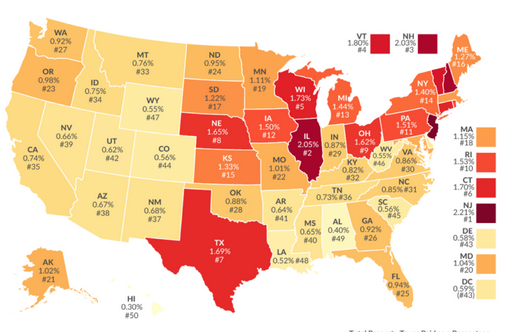Greg Abbott’s $18 billion tax cut package for Texas homeowners came into force on Monday, but many residents complained to Newsweek that they are still facing impossibly high taxes on their homes.
Property Taxes by the state

Property Taxes
Despite
having no personal income tax—a perk that has attracted many to move to
the Lone Star State—Texas has some of the country’s highest taxes.
Abbott campaigned for re-election in 2022 with the goal to ease this
financial pressure on the state’s residents, and last year he put to
voters a decision over his tax cut package.
Texans
overwhelmingly voted in support of the historic measure, which
increased the amount of a home’s value that cannot be taxed to pay for
public schools from $40,000 to $100,000. Republican Senator Paul
Bettencourt of Houston said the bill would help Texas residents to save
on average $1,300 a year in property taxes.
Some Texans told Newsweek they
were pleased by the measure. But many others wrote to complain that
they’re not eligible for the homestead exemption or that they’re still
paying burdensome taxes despite benefiting from the raise in the
exemption. The blame was not laid entirely at Abbott’s door, with the
appraisal system coming in for particular criticism.
One way
to ease the tax burden across Texas is to buy down school districts’
maintenance and operations (M&O) taxes, which is about half of the
property tax burden. This could be done by limiting state spending and
using any surplus funds to cut the local property tax until it is
eliminated, which could take roughly a decade, moving Texas towards
sales taxes as they are the state’s top revenue source.
However, this could be difficult to maintain session after session with
the limitations on state and local government spending to achieve this
in a timely manner, if at all.
Another
way is for the state to immediately replace school M&O taxes with
higher sales taxes. An immediate swap would eliminate the risk that the
switch to a final sales tax would be only temporary, a failure common to
past
Tax relief efforts. However, an immediate switch may be politically
challenging to implement, so a way to mitigate this is to limit state
spending and use surplus funds to cut the sales tax rate over time.
Switching
M&O costs to sales taxes is not the only measure local (or state)
governments should adopt. The other, and possibly even more fundamental
to reducing barriers for opportunities to let people prosper, is implementing sound budgetary practices.
By
reducing government spending through things like freezing new hires and
pay raises and placing a moratorium on incurring any new
taxpayer-funded debt, there are plenty of opportunities to cut taxes.
Local
governments should volunteer for third-party audits to determine where
areas of waste can be eliminated along with expensive lobbying contracts
and longevity pay. Ultimately, practicing zero-based-budgeting, whereby
local governments must justify every expenditure, could help achieve
setting budget priorities that support effective government programs.
Any
government approach to supporting an economic recovery in the wake of
COVID-19 must begin with easing the burden on Texas taxpayers, and that
approach must include reducing the burden of soaring taxes and
implementing sound budgeting at all levels of government.
The article accompanying the map
acknowledges that Texas to some extent relies on high taxes in lieu of
other tax categories – i.e., income taxes – though other states without
an income tax do not necessarily have a high tax burden (e.g.,
Florida). Regardless, in an economy hampered by COVID-19 and government
lockdowns and with homeowners under substantial financial and mental
stress, local governments have a responsibility to reduce the burden on
taxpayers.










